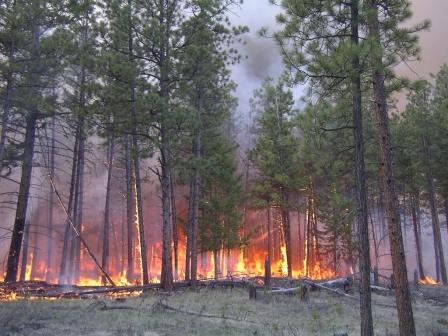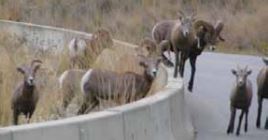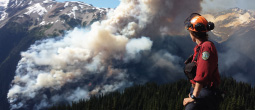Safety while on rangeland
Safe practices while on rangeland helps protect people, wildlife, sensitive ecosystems, livestock and domestic animals. Take care, especially in areas where active logging and hauling are taking place and where there are known predators.
The provincial government places a great emphasis on safety on the range, especially in areas where active logging and hauling are taking place and where there are known predators.
Driving through rangeland
Keep your vehicle on well-defined roads and trails. During dry conditions, the catalytic converter on your vehicle (or the exhaust alone) could spark a wildfire. If you spot a fire, report it immediately by calling 1-800-663-5555 toll-free or *5555 on your cellphone. If you smoke, use your ashtray. Never discard cigarette butts on rangelands or along roads.
Moderate your speed as needed, especially when passing cattle that are in the road right-of-way. Calves may bolt as you approach, especially if they are separated from their mother.
Leave gates as you find them. If a gate was closed before you passed through it, be sure to close it again after you.
Also, please be aware that handlers and working dogs might be present.
Around livestock
Let livestock know you’re nearby by speaking loudly and making some noise. Cattle and horses have very good peripheral vision that allows them to detect movement, but they have very poor depth perception compared to humans and wild predators. Initially, they will likely see you as a potential predator and may spook unless you speak to them so they know you are human.
Livestock will follow the easiest travel route if that’s an option, so don’t be surprised to find them walking in open areas, on roads and on game trails where the going is easy. Give them a wide berth and make sure you leave them an escape route. Don’t get between a cow and her calf or between a mare and her foal. The mothering instinct is strong in cattle and horses and they will react to what they see as a threat.
Don’t approach bulls or stallions, since they are territorial and might see you as a threat. They are much bigger than you and could do you serious harm.
Control your dogs at all times. Dogs can spook cattle or cause them to become aggressive toward you
On resource roads
If you have a two-way radio, use it when travelling on forest service roads, or roads under permit by timber licensees, to call out your location (in kilometres from where the road begins). Applicable radio frequencies and information are posted at the starting points of resource roads. If you don’t have a two-way radio, drive at a safe speed, pay close attention to the road and always give logging trucks the right of way.
Keep a safe distance between your vehicle and other traffic on resource roads. Roads can be wet, slippery or dusty, which may create hazardous driving conditions that could affect visibility and your ability to control your vehicle. Many resource roads are deactivated once they are no longer needed to remove timber from a harvesting area. Drive with caution, since these roads may be impassable for some vehicles. Off-road vehicles (ORVs) used for recreational activities may also use Crown land. With appropriate licensing and insurance, these vehicles are allowed to use forest service roads, but off-road vehicle operators must follow the same rules as other vehicular traffic. Stay alert and respect other drivers.
Wildlife
You may encounter a variety of wildlife on rangelands or in the backcountry, including bears, wolves and cougars. Educate yourself on how to respond in the event of a wildlife encounter. Stay clear of any dead animals or kill sites that you come across, since the predator may still be in the area. Make your presence known by talking loudly, clapping or calling out while travelling in the backcountry, so you don’t surprise wildlife. Always carry safety gear (bear spray, for example) and know how to use it. It could save your life. If wildlife or livestock appear on the road you’re using, give them time and space to disperse. Do not chase the animals and only pass them after they have moved away from the road.
Wildfires
Before you head into the backcountry, tell someone you trust where you are going and when you expect to return. If you get lost or stranded while driving, stay with your vehicle. It will provide shelter until help arrives and it is much easier to locate than an individual in the woods. Be prepared for anything. Always carry some food, water and basic first aid supplies in case of an accident. Don’t depend on your cellphone in the wilderness, since it may not be able to connect to a network or it may lose power. Report all wildfires and respect fire bans.


Wildlife can be unpredictable. Learn about rangeland safety.
BC Wildfire Service
Report a wildfire: 1-800-663-5555
- or *5555 on a cell
Fire information: 1-888-336-7378
Burn registration: 1-888-797-1717
Contact information
Contact your Natural Resource District and Range Officer if you have questions about rangeland use in a specific Natural Resource District. Please direct general questions to:
Forests.RangeBranch@gov.bc.ca
Range.GrazingLeases@gov.bc.ca
Invasive.Plants@gov.bc.ca
Range.Practices@gov.bc.ca
Range.GrazingPolicy@gov.bc.ca

